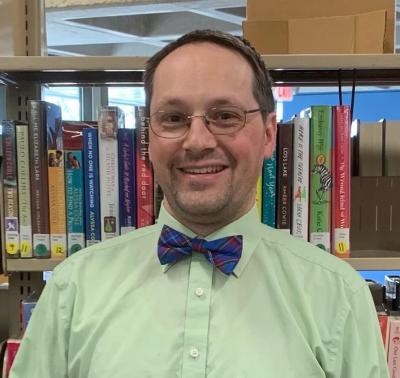New Ulm, Minnesota, is located on the northern edge of Tornado Alley, an area of the central United States with frequent damaging tornadoes. The city’s location, between two rivers, makes it especially vulnerable to the effects of climate change. Flooding is growing more common and worse seemingly each passing year, along with tornadoes, drought, hail, and onslaughts of mosquitos and ticks during summer months.

In 2020, the New Ulm Public Library received a Resilient Communities: Libraries Respond to Climate Change grant from ALA to engage their community in programs and conversations that address the climate crisis. When librarian LeRoy Harris was designing programs for the grant, he saw the untapped potential of faith communities in New Ulm.
“Faith communities motivate people to do good,” said Harris, “whether that be through lifting up fellow humans that are struggling or promoting environmental stewardship in being grateful for and kind to our planet.”
LeRoy contacted 21 faith communities in New Ulm and explained that the library hoped to partner with them to create an Interfaith Weather Emergency Preparedness Council. I spoke to LeRoy to learn about this process and how it has brought a new awareness and preparedness to people in New Ulm.
What made you want to work with faith communities on climate change?
Faith communities are important to community outreach. When it comes to emergency preparedness, churches have contact with homebound people, people struggling financially or health-wise, people who may have an aversion to governmental assistance, etc. We wanted to make sure that when there is a weather disaster in our town, these faith communities will be able to reach out to the people that need it most with appropriate resources and assistance.
What was the first step once you had the weather council formed?
Once I had a good group that had responded to my call, we outlined our visions. Visions will vary from community to community depending on geography-specific weather emergencies, size and demographics, resources of the library, and individual faith communities. Weather councils are not modular; they are something that have to be planned to each specific community.
For New Ulm, we knew that we wanted to offer weather emergency training for faith communities, but we didn’t know specifically what help they needed. We started by creating an online survey that asked faith leaders what they might have to prepare for, what their communications channels were, what physical resources they have, and what types of people in their faith community could aid in an emergency. Do they have doctors? Nurses? Or people that are involved in different fields that can help in an emergency?
We anonymized the results and shared them with local emergency management personnel and had a meeting with the county emergency manager. Emergency management told us what they could offer us, resource-wise. The library determined what we could offer the faith communities in terms of education and preparedness resources.
What types of training are you offering?
Once we are prepared for what each community is looking for, we schedule the trainings. Some faith communities opted for having their leadership attend. Others invited their whole congregations.
Trainings will go over emergency kit contents and creating an organizational or household emergency plan. The library and emergency management staff will act as moderators between setting goals and sending people in the right direction with resources. We are hoping to lay a strong foundation now, so when the next weather emergency inevitably happens, more people are educated and can aid others.

What advice do you have for libraries who want to create their own interfaith emergency preparedness councils?
I have three important starting recommendations. Number-one is to work on your listening skills. Whenever you make that initial outreach communication, listen to what they need or don’t know. Don’t fit them into the program box; design a structure according to their needs. When people know they are valued, it makes a difference in how they respond and how much time they invest.
My second bit of advice is to learn a bit about how different faith communities are structured. There is incredible variety in the way people structure their organizations, and having a better understanding can help you use their right vocabulary when you speak to them. Research can go a long way; it shows you have taken the time to get to know them and are authentic in your desire to help.
Finally, regardless of how serious the topic is, always make a program enjoyable. Enjoyable doesn’t necessarily mean that everyone is laughing, but that people feel good about having participated. Participants can come away saying they learned something, they are motivated, they want to come back and they want to share what they’ve learned. Because of your program, they can take the pieces of the puzzle and make it into something beautiful.



